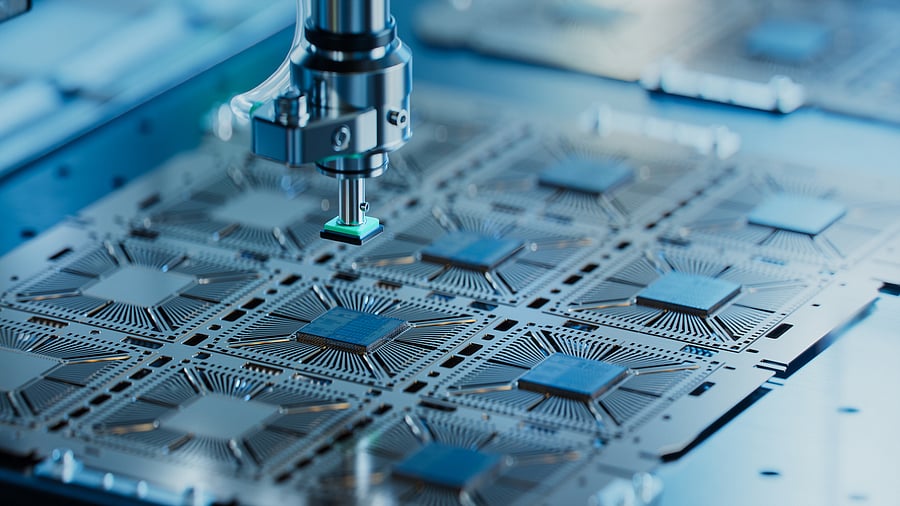
Image illustrative of semiconductor fabrication.
Credit: iStock Photo
Two major semiconductor chip fabrication projects have been paused or closed in the last few days. First, the Adani group paused discussions with Israel’s Tower Semiconductor for a $10 billion chip project as it was not making strategic and commercial sense. Second, software firm Zoho suspended its pursuit of a $700 million plan to expand into chip manufacturing, finding it too capital intensive.
For context, the Government of India (GOI) had announced a Rs 760 billion (at that time $10 billion) Semiconductors India Programme (SIP) in December 2021. Under the SIP, by the end of 2023-2024, the GOI had approved three OSAT (outsourced semiconductor assembly and test) facilities — of Tata Electronics Private Ltd. (TEPL), CG Power and Industrial Solutions Limited (CGPISL) and Keynes Technology India Limited (KTIL). In addition, a semiconductor fab facility of TEPL and US chip maker Micron’s semiconductor fabrication plant coming up at Sanand in Gujarat, were also approved.
In all, five semiconductor fabrication facilities have been approved, which, as a senior official (IT secretary S Krishnan), informally stated in March, used almost all the funds under the Rs 760 billion SIP. He also mentioned that about four to five new projects were pending for consideration, which would be taken up only after the GOI approves SIP2.0.
With the Adani and Zoho projects, part of these four or five probable projects, folding up, is there enough interest for the GOI to come up with SIP2.0? Does closure by these two strong entities indicate that the Indian industrial ecosystem does not see any opportunities in semiconductor fabrication plants?
Is it a temporary setback, or is the semiconductor game over?
India a minor chip manufacturer
The semiconductor industry reports 438 semiconductor manufacturing plants worldwide in 2024, with Japan (103), the United States (95), China (81) and Taiwan (80) accounting for the bulk of it. In terms of production, Taiwan fabricates 60 per cent of all global chips and 90 per cent of advanced chips. India had four fabrication plants with miniscule production.
The global semiconductor industry sales crossed $627.6 billion in 2024, growing 19.1 per cent in a year. In terms of share, US companies sold about 50 per cent, followed by South Korea (14 per cent), Europe (12 per cent), Japan (9 per cent), Taiwan (7 per cent), and China (7 per cent). Indian companies hardly sold any semiconductor chips.
India is a bit player in the semiconductor chip space.
Government wanted to change the game
The Rs 76,000 crore SIP is aimed at the fast development of the semiconductors and display manufacturing ecosystem by promising incentives for every part of the production and supply chain.
For semiconductor fabs and display fabs, the GOI promised capital incentives up to 50 per cent of project cost, with the state governments also expected to pitch in with additional support in the form of land and other fiscal incentives. For compound semiconductors, silicon photonics and other semiconductor facilities, the GOI promised 30 per cent of capital expenditure as an incentive, which was later increased to 50 per cent.
After considerable efforts, India did see approval of five facilities, which are in different stages of construction. When complete, these five facilities will put India on the map of semiconductor manufacturers but will not greatly change the game.
A quite small programme
Over the last few years, semiconductor manufacturing has caught the fancy of all major industrial powers.
The Donald Trump administration approved incentives for three semiconductor fabs in January under the CHIPS Act, taking US commitments to $33 billion out of a $36 billion budgeted for chip incentives. The approved plants, spread over 22 states, are expected to result in $450 billion in private investments.
In May 2024, China set up its third State-backed investment fund to boost its semiconductor industry, with planned investment incentives of $47.5 billion. In November, the Japanese government announced a $65 billion plan to support the semiconductor industry. The EU also has a $47 billion programme.
In all, the total global incentives of about $380 billion have been announced for supporting semiconductor chip manufacturing. Given this, India’s $10 billion incentive is too small to make any meaningful difference.
End of the road?
Chip manufacturing is a highly complex process. It requires high-precision tools, machines, and a very sophisticated industry support system. The semiconductor chip manufacturing value chain is monopolised by a few in the world.
Further, with Taiwanese companies having built such massive chip manufacturing capacity, it is almost impossible for newcomers to compete with them on technology, quality, and cost.
These explain why the Adani group concluded that it did not ‘make strategic and commercial sense for the group’. Zoho found it difficult to even locate a technology partner.
Krishnan, while alluding to GOI considering an SIP2.0, mentioned two proposals — a HCL Group-Foxconn joint venture and Hiranandani Groups’ Tarq Semiconductors. Going by the latest developments, it seems unlikely that these two projects would also be followed up.
It does not appear that there would be an SIP2.0. It seems to be game over for any more new semiconductor fab plants.
(Subhash Chandra Garg is former Finance & Economic Affairs Secretary, and author of ‘The Ten Trillion Dream Dented’, ‘Commentary on Budget 2025-2026’, and ‘We Also Make Policy’)
Disclaimer: The views expressed in the article are the author's own. They do not necessarily reflect the views of DH.